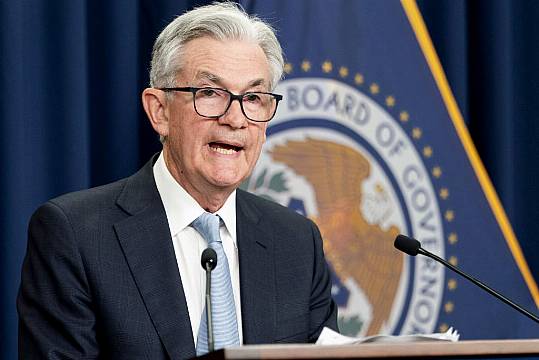The Federal Reserve has intensified its drive to tame high inflation by raising its key interest rate by three-quarters of a point — its largest hike in nearly three decades.
The move the Fed announced after its latest policy meeting will raise its benchmark short-term rate, which affects many consumer and business loans, to a range of 1.5% to 1.75%.
With the additional rate hikes they foresee, the policymakers expect their key rate to reach a range of 3.25% to 3.5% by year’s end — the highest level since 2008 — meaning that most forms of borrowing will become sharply more expensive.
Read Chair Powell's full opening statement from the #FOMC press conference (PDF): https://t.co/KqX2HvrvD6 pic.twitter.com/plBgXA16ie
— Federal Reserve (@federalreserve) June 15, 2022
Advertisement
The central bank is ramping up its drive to tighten credit and slow growth with inflation having reached a four-decade high of 8.6%, spreading to more areas of the economy and showing no sign of slowing.
Americans are also starting to expect high inflation to last longer than they had before. This sentiment could embed an inflationary psychology in the economy that would make it harder to bring inflation back to the Fed’s 2% target.
The Fed’s three-quarter-point rate increase exceeds the half-point hike that Chair Jerome Powell had previously suggested was likely to be announced this week.
The Fed’s decision to impose a rate hike as large as it did on Wednesday was an acknowledgment that it is struggling to curb the pace and persistence of inflation, which has been worsened by Russia’s war against Ukraine and its effects on energy prices.
Asked at a news conference why the Fed was announcing a more aggressive rate hike than he had earlier signalled it would, Mr Powell replied that the latest reports had shown inflation to be hotter than expected.
“We thought strong action was warranted at this meeting,” he said, “and we delivered that.”
Inflation has shot to the top of voter concerns in the months before Congress’ midterm elections, souring the public’s view of the economy, weakening President Joe Biden’s approval ratings and raising the likelihood of Democratic losses in November.
Mr Biden has sought to show he recognises the pain that inflation is causing American households but has struggled to find policy actions that might make a real difference.
The president has stressed his belief that the power to curb inflation rests mainly with the Fed.
Yet the Fed’s rate hikes are blunt tools for trying to lower inflation while also sustaining growth. Shortages of oil, petrol and food are propelling inflation.
The Fed is not ideally suited to address many of the roots of inflation, which involve Russia’s invasion of Ukraine, still-clogged global supply chains, labour shortages and surging demand for services from airline tickets to restaurant meals.
Borrowing costs have already risen sharply across much of the US economy in response to the Fed’s moves, with the average 30-year fixed mortgage rate topping 6%, its highest level since before the 2008 financial crisis, up from just 3% at the start of the year.
The yield on the two-year Treasury note, a benchmark for corporate borrowing, has jumped to 3.3%, its highest level since 2007.
Even if a recession can be avoided, economists say it is almost inevitable that the Fed will have to inflict some pain — most likely in the form of higher unemployment — as the price of defeating chronically high inflation.
In their updated forecasts on Wednesday, the Fed’s policymakers indicated that after this year’s rate increases, they foresee two more rate hikes by the end of 2023, at which point they expect inflation to finally fall below 3%, close to their 2% target.
But they expect inflation to still be 5.2% at the end of this year, much higher than they had estimated in March.
Over the next two years, the officials are forecasting a much weaker economy than was envisioned in March. They expect the unemployment rate to reach 3.7% by year’s end and 3.9% by the end of 2023. Those are only slight increases from the current 3.6% jobless rate.
But they mark the first time since it began raising rates that the Fed has acknowledged that its actions will weaken the economy.
The central bank has also sharply lowered its projections for economic growth, to 1.7% this year and next. That is below its outlook in March but better than some economists’ expectation for a recession next year.
Expectations for larger Fed hikes have sent a range of interest rates to their highest points in years. The yield on the two-year Treasury note, a benchmark for corporate bonds, has reached 3.3%, its highest level since 2007.
The 10-year Treasury yield, which directly affects mortgage rates, has hit 3.4%, up nearly a half-point since last week and the highest level since 2011.
Investments around the world, from bonds to bitcoin, have tumbled on fears surrounding high inflation and the prospect that the Fed’s aggressive drive to control it will cause a recession.
Even if the Fed manages the delicate trick of curbing inflation without causing a recession, higher rates will nevertheless inflict pressure on stock prices. The S&P 500 has already sunk more than 20% this year, meeting the definition of a bear market.







